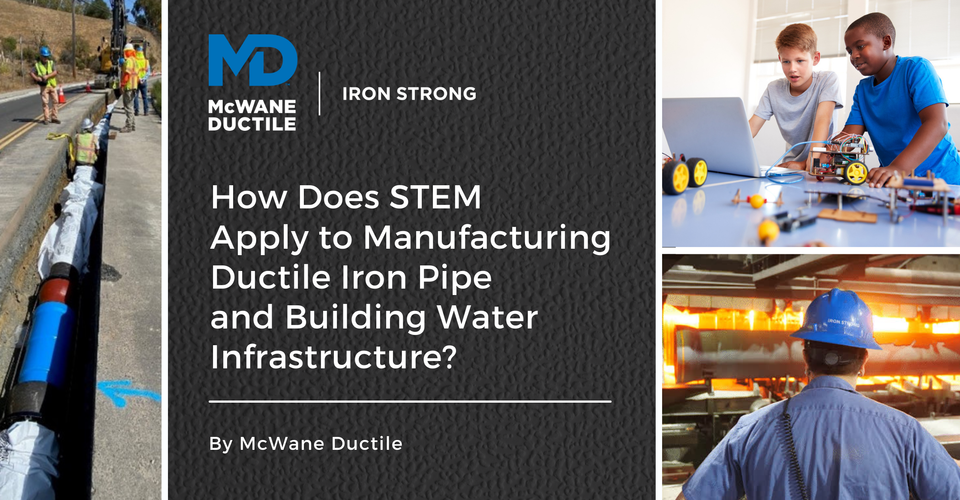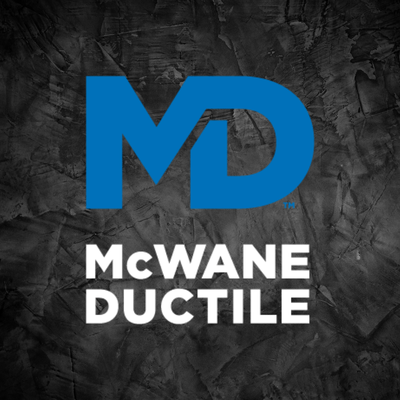November 8 is National STEM/STEAM Day, highlighting the importance of Science, Technology, Engineering, Arts, and Mathematics in children’s education. The manufacturing of Ductile iron pipe (DI pipe) and constructing pipelines for water and wastewater infrastructure are complex processes that rely heavily on STEM principles. In this #IronStrong Blog, we will explore the intricate connections between these fields and their significance in ensuring safe and efficient water and wastewater management now and in the future.
History of STEM/STEAM Day
Studies in the early 2000s revealed that U.S. students were not achieving in the STEM disciplines at the same rate as students in other countries. The report predicted dire consequences if the country could not compete in the global economy due to a poorly prepared workforce. Thus, educators focused attention on science, math, and technology research, economic policy, and education. U.S. prosperity seemed to depend on it.
The international comparisons fueled discussion of U.S. education and workforce needs. The bipartisan congressional STEM Education Caucus noted: “Our knowledge-based economy is driven by constant innovation. The foundation of innovation lies in a dynamic, motivated, and well-educated workforce equipped with STEM skills.” 2
Growth in America’s STEM jobs in the first decade of the 21st century tripled the growth rate in non-STEM jobs. However, employers continue to struggle with the need for qualified STEM workers. “To remain competitive in the evolving global market, the United States needs a workforce skilled in science, technology, engineering, and math. STEM careers are growing faster than any other sector, and students who bring STEM degrees and skills to the workforce have higher wages than their counterparts and starting salaries more than 30 percent higher than those for non-STEM jobs.” 3
Science in Ductile Iron Pipe Manufacturing
Science forms the foundation of nearly all manufacturing processes, and the production of Ductile iron pipe is no exception: Ductile iron, a material known for its strength and durability, results from scientific research and metallurgy. The transformation of gray cast iron into Ductile iron involves adding small quantities of magnesium and other elements, which changes the microstructure of the metal. This alteration improves mechanical properties, making it ideal for pipe manufacturing. Scientists have played a pivotal role in discovering and refining these metallurgical processes.
Furthermore, material science is critical in ensuring the longevity of DI pipe. Research on corrosion resistance and material degradation is vital to developing pipes that can withstand harsh underground environments. Scientific knowledge also informs the design of protective coatings and pipe linings, enhancing their durability and lifespan.
Technology in Ductile Iron Pipe Manufacturing
Technology plays a central role in modern manufacturing. Advanced machinery, automation, and quality control systems are essential components of the DI pipe manufacturing process. Computer-aided design (CAD) and computer-aided manufacturing (CAM) systems allow engineers to design intricate pipe structures and precisely control the machinery that produces them.
Additionally, automation and robotics are employed in various manufacturing stages, from casting to quality assurance. These technologies improve efficiency, reduce human error, and enhance safety. For instance, robotic arms can handle heavy components, reducing the risk of workplace injuries.
Furthermore, integrating data analytics and sensors into the manufacturing process has revolutionized quality control. Real-time data from sensors can detect deficiencies or variations in pipe production, allowing for immediate corrective actions and ensuring the quality of the pipes. It also reduces waste and production costs.
Engineering in Pipeline Construction
Engineering is at the core of pipeline construction for water and wastewater infrastructure. This encompasses various aspects, including structural engineering, civil engineering, and environmental engineering.
Structural engineering is vital in designing pipelines that can withstand external forces, such as soil conditions, traffic loads, and seismic events. Engineers use mathematical models and simulations to analyze stress and strain in pipelines, ensuring their integrity and longevity. These calculations are rooted in principles of physics and mathematics.
Civil engineering is crucial in planning and executing the layout of pipelines, considering the topography and terrain of the region. Engineers must design the pipeline routes to minimize environmental impact, avoid obstacles, and optimize accessibility for maintenance and repairs. This requires a deep understanding of geology, soil mechanics, and hydraulic engineering principles.
Environmental engineering is integral to managing the environmental impact of pipeline construction and operation. Engineers are responsible for ensuring that pipelines do not harm local ecosystems, water sources, or communities. They design systems for wastewater treatment and effluent disposal, ensuring compliance with environmental regulations. This requires expertise in biology, chemistry, and environmental science.
Arts and Design in Pipeline Construction
While STEM fields are the bedrock of pipeline construction, the Arts, mainly design and aesthetics, can also be applied. The visual aspects of infrastructure projects can influence public perception, community acceptance, and even tourism. Therefore, the aesthetic design of water and wastewater infrastructure should be considered.
Architects and landscape designers collaborate with engineers to create aesthetically pleasing pipeline routes that blend harmoniously with the natural surroundings. Integrating art and design into engineering projects is known as "landscape architecture," where creativity and aesthetics are combined with technical knowledge to ensure the arrangement of pipelines and pumping stations do not negatively impact the overall landscape and quality of life for residents.
Mathematics in Pipeline Design and Optimization
Mathematics is vital in all aspects of pipeline design and optimization, such as hydraulic calculations, optimization of pipe networks, risk assessment and reliability analysis, and cost estimation. Engineers use mathematical equations to determine the pipe diameter, flow rates, and pressure requirements to ensure efficient water distribution. Mathematical optimization techniques are employed to design efficient pipe networks. These methods minimize costs while ensuring adequate water supply and pressure throughout the network.
Mathematical modeling is used to assess the risk of pipeline failures and predict their consequences. Engineers use probability theory and statistical analysis to estimate the likelihood of different failure scenarios and plan preventive measures accordingly. Mathematics is also instrumental in estimating the cost of pipeline construction and maintenance. Utility managers and engineers use mathematical formulas and cost analysis techniques to budget for materials, labor, equipment, and ongoing operational expenses.
Mathematics plays an essential role in sustainability assessments. Engineers use mathematical models to evaluate the environmental impact of pipeline construction and operation. This includes analyzing factors such as carbon emissions, energy efficiency, and water conservation.
STEM Education and Workforce Development
To ensure the continued advancement of water and wastewater infrastructure, there is a growing need for a skilled workforce with expertise in STEM fields. This includes engineers, scientists, technicians, and skilled tradespeople capable of manufacturing pipe, constructing pipelines, and maintaining water systems. We must also support the educators who are required to have an in-depth knowledge of STEM careers. They must be prepared to guide the next generation of young professionals in those fields.
McWane Ductile believes skilled trade workers with STEM expertise are integral to keeping American manufacturing strong and ensuring the safety and sustainability of our country’s water systems. Therefore, we actively engage in our local schools and community career centers and provide numerous yearly internships to college students. DID YOU KNOW that McWane offers the McWane Scholarship Program for Skilled Trades, an initiative to promote trade and technical education? Apply today at applyists.com.
Need Assistance with Your Waterworks Project?
If you have any questions regarding your water or wastewater infrastructure project, contact your local McWane Ductile representative. We have team members who've managed small and large water utility systems, served in engineering consulting firms, and bring decades of experience in solving field issues involving pipeline construction and operation. From design to submittal, to installation, we strive to provide education and assistance to water professionals throughout the water and wastewater industry.
Check Out All Our Digital Offerings
- More articles and videos from our Iron Strong Blog
- Training Opportunities with McWane Ductile
- The McWane Pocket Engineer
- Engage with us on LinkedIn
- Subscribe to our YouTube Channel
- Follow us on Facebook
- Follow us on X
Citations
- (2023). ChatGPT (August 3 Version) [Large language model]. https://chat.openai.com
- National Today, “STEM/STEAM Day,” Accessed November 7, 2023, https://nationaltoday.com/stem-steam-day/
- Committee on Science Space and Technology. “STEM,” Accessed November 7, 2023, https://science.house.gov/stem







